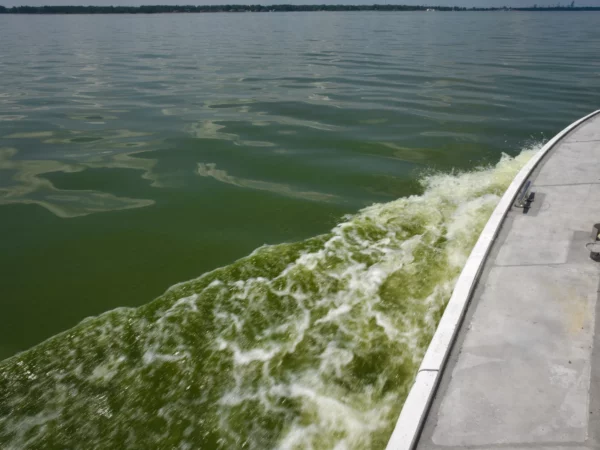
PFAS, short for per- and polyfluoroalkyl substances, are a group of widespread man-made chemicals that don’t break down in the environment or the human body and have been flagged as a major contaminant in sources of water across the country.
Keep up with PFAS-related developments in the Great Lakes area.
Click on the headline to read the full story:
Illinois:
- Foam containing ‘forever chemicals’ likely used to extinguish Chemtool fire in Illinois – Milwaukee Journal Sentinel
Firefighting foam that likely contained “forever chemicals” was used in an attempt to quench the flames in a manufacturing facility fire this week, risking contamination of the Rock River.
Fluorinated foam — which contains PFAS or can break down to form the chemicals — was used on the Chemtool fire earlier this week, according to the Illinois Environmental Protection Agency. The agency responded to the fire Monday and has been monitoring the air quality in the surrounding area.
Michigan:
The Kalamazoo City Commission approved spending $170,423 for PFAS testing following a spill of firefighting foam at the Kalamazoo/Battle Creek International Airport.
The city commission approved the item during its Monday, June 7, meeting.
- State officials to continue testing Grayling sites for PFAS – Interlochen Public Radio
Testing of water sources near Camp Grayling for PFAS contamination will continue this summer.
Last year, the state Department of Health and Human Services sampled more than a thousand residential wells near the Michigan National Guard’s training center.
Now the health department wants to test many of those wells again.
Officials found homes in the area with PFAS levels at or higher than 70 parts per trillion, which is an EPA advisory level for PFAS. The industrial chemicals are toxic and have been linked to health problems like cancer.
Two former Air Force bases in Michigan are on a “Filthy Fifty” list of sites where the U.S. Defense Department would have to expedite cleanup of toxic “forever chemical” contamination under new Congressional legislation.
Wurtsmith Air Force Base in Oscoda and K.I. Sawyer Air Force Base in the Upper Peninsula are among priority installations with toxic PFAS pollution marked for speedier cleanup under the bill package, which allocates $10 billion for remedial work nationwide and puts the Pentagon under a deadline schedule to complete construction.
Minnesota:
- Bemidji City Council reaches consensus on water connection incentives – The Bemidji Pioneer
Bemidji property owners with private wells may receive incentives in the future to connect to the city’s water system.
The incentives were recommended to the Bemidji City Council Monday as a way to assist residents who live not far from where chemicals known as PFAS have been discovered.
Pennsylvania:
- PFAS chemicals found in a third of water samples, state says – The Associated Press
Gov. Tom Wolf’s administration said the results of a statewide sampling program do not indicate widespread contamination of drinking water supplies by a class of highly toxic chemicals used in products like nonstick cookware, carpets, firefighting foam and fast-food wrappers.
Of more than 400 sites tested across Pennsylvania, about one-third were found to contain one of the chemicals, according to results posted online Thursday by the Department of Environmental Protection.
Wisconsin:
- Environmental groups seek to intervene in WMC’s PFAS cleanup lawsuit – The Capital Times
Environmental advocates are seeking to intervene in a lawsuit they say would “severely undermine” the state Department of Natural Resources’ ability to protect Wisconsin communities from hazardous substances, including PFAS chemicals.
The lawsuit, filed against the DNR in February by Wisconsin Manufacturers and Commerce and Oconomowoc-based dry cleaner Leather-Rich, Inc., alleges that the agency is acting outside of its legal authority by requiring businesses to investigate and clean up “emerging contaminants” such as PFAS under two environmental cleanup programs.
- Republicans eliminate proposed DNR programs from budget, including several measures to fight ‘forever chemical’ contaminations – Milwaukee Journal Sentinel
Republican lawmakers in charge of the state’s budget-writing process eliminated a number of key initiatives aimed at confronting a growing number of “forever chemical” contaminations across the state.
Members of the state’s Joint Finance Committee voted to eliminate 11 proposed scientist positions for the Department of Natural Resources, a grant program for communities fighting a contamination and a program that would test all public water supplies for the toxic chemicals.
- Testing detects PFAS in more than 500 French Islands wells, state looks to next steps – La Crosse Tribune
he last results from a large water sampling from the state have been finalized, showing that now more than 500 wells on French Island have some level of PFAS in them, with around 150 of those above state groundwater standards.
A total of 165 private and public wells have been shown to have levels of PFAS exceeding Wisconsin’s recommended standards of 20 parts per trillion or its hazard index, though 538 showed some level of the toxic chemicals, further indicating that the pollution on the island is more widespread than originally thought.
National:
- Firefighters denied coverage by Veterans Affairs after exposure to PFAS firefighting foam – The Intercept
While almost everyone has PFAS in their blood through exposure to water, dust and everyday products that contain the chemicals, firefighters may have greater contact with PFAS than any other group of workers. In addition to using — and often getting doused with — firefighting foam known as AFFF, it has become clear in recent years that the clothing that was supposed to protect them while fighting fires, known as turnout gear, is also saturated with PFAS.
- New Study Finds PFAS in Bottled Water, as Lawmakers Call for Federal Limits – Consumer Reports
Some noncarbonated bottled water products sold in the U.S. and tested as part of a new study contained potentially toxic PFAS chemicals, prompting calls for the federal government to set standards covering the chemicals.
The study, published in the journal Water Research and led by Johns Hopkins University researchers, detected PFAS substances in 39 out of more than 100 bottled waters tested, in some cases at levels deemed concerning by water quality experts.
- Study: Half of US cosmetics contain toxic chemicals – The Associated Press
More than half the cosmetics sold in the United States and Canada are awash with a toxic industrial compound associated with serious health conditions, including cancer and reduced birth weight, according to a new study.
Researchers at the University of Notre Dame tested more than 230 commonly used cosmetics and found that 56% of foundations and eye products, 48% of lip products and 47% of mascaras contained fluorine — an indicator of PFAS, so-called “forever chemicals” that are used in nonstick frying pans, rugs and countless other consumer products.
- Wendy’s, States Ditch Food Wrappers With ‘Forever Chemicals’ – Bloomberg Law
Fast-food restaurants and grocery store chains are joining a growing number of states in pushing “forever chemicals” out of food packaging, despite a federal thumbs-up that allows PFAS to touch what people eat.
Burger wrappings, salad bowls, pet food bags, and other packaging use some of the chemicals in the PFAS family to repel oil and grease. Companies also use per- and polyfluoroalkyl substances to protect food-processing equipment from heat and other stressors.
But some PFAS don’t break down in the environment, and their links to health problems ranging from high cholesterol to cancer have triggered alarms across the U.S. and abroad.
Catch up on more PFAS news on Great Lakes Now:
Raining PFAS: Amount of PFAS found is outpacing legacy contaminants
API key not valid. Please pass a valid API key.Featured image: The former Wurtsmith Air Force base in Oscoda, Mich., is responsible for PFAS in groundwater in nearby communities. (Great Lakes Now Episode 1025)
1 Comment
-
Thank you for this article. I had no idea and will do more to advocate for clean water and the banning of forever chemicals




